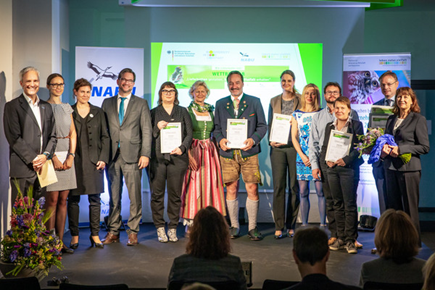A year ago, I was convinced that the protection of biodiversity would only be at the top of the agenda, if people no longer found fruit and vegetables on their supermarket shelves. Until now, I had little hope that biodiversity would become a top issue. This has changed in the last three months.
On February 14th, the petition for the referendum "Biodiversity - Save the bees" collected more than 1.7 million signatures within a few days in the German state of Bavaria and made history as the most successful petition for a referendum in Bavaria.
However, there was only a brief respite when we received the alarming news from the World Biodiversity Council on May 6th: Around one million animal and plant species are threatened by extinction. Alas, another finding of the report showed, that the setting-aside of land for conservation has had no effect on the ongoing extinction of species.
Promoting Diversity
In light of these findings, what can we do to promote biodiversity? In my experience as a forest scientist at UPM Communication Papers, companies hold a big stake in promoting biodiversity within their supply chains. We have been pursuing a biodiversity programme at UPM for 25 years, in which, for example, we systematically map valuable habitats, preserve their conservation value while harvesting, and implement concrete measures to increase the diversity of habitats and species.
"The good news is: any company can promote biodiversity "
Naturally, a paper manufacturer can do that well because it has a direct link to the forest. The good news is: any company can promote biodiversity, be it through measures in the supply chain, as with UPM, or on the company's premises, such as creating a wildflower meadow. Even for pure service companies, a careful assessment of their own environmental impact can provide tangible measures - it takes good ideas and, of course, the will to implement them. This benefits not only the environment, but also the corporate reputation, which is why I would like to share six practical and sometimes surprising examples from German companies with you, ranging from small family businesses to SMEs and large companies.
Six examples of more biodiversity in the supply chain
On May 22nd, Biodiversity Day, I had the opportunity to meet the following six companies that demonstrate that biodiversity is possible in almost every industry. They are all finalists in the "The supply chain is alive" competition. As Chairwoman of the Board of the "Biodiversity in Good Company" initiative, I had the privilege to present this award for biodiversity together with the Nature and Biodiversity Conservation Union (NABU) and the German Federal Ministry for the Environment, Nature Conservation and Nuclear Safety (BMU). More about the competition and the winners can be read here.
- Bestattungshaus Hebenstreit & Kentrup GmbH – Coffins and urns made from local wood, grave monuments from regional quarries and seasonal grave planting demonstrate that biodiversity can also be implemented by service companies with good ideas.
- Alnatura Produktions- und Handels GmbH – An entire orientation towards organic agriculture and biodiversity, including the establishment of biodiversity areas and the promotion of old crops, demonstrates that biodiversity can become a strategic business orientation.
- Berghotel Rehlegg – Supports the settlement of old livestock breeds through a balanced demand and demonstrated by five of their own bee colonies and the cultivation of old fruit tree species that new ecosystems can be created directly on company grounds.
- Milchwerke Berchtesgadener Land Chiemgau eG – 1,700 farmers voted against the use of total herbicides and reached a milestone in conventional agriculture by doing so.
- followfood GmbH – Makes the supply chain visible to consumers through a transparent track & trace system for food and mitigates weaknesses in the value chain by supporting reforestation projects.
- PERÚ PURO GmbH – On heavily degraded areas in Peru, the endangered original cocoa variety "Chuncho" is cultivated by small farmers who are trained in biodiversity.

Photo credit: NABU/ Adam Sevens
Living supply chains have an advantage as soon as the true price of products becomes visible!
The public debate on biodiversity has gained some ground. However, the report of the Intergovernmental Panel on Climate Change (IPCC) shows that much more will be needed to turn the public discourse into effective economic practices. Politicians are called upon to design a framework that does not advantage economic activities that operate at the expense of species protection. The actual price of currently cheap products, including the damage they cause to our environment, must become visible at the counter. Meanwhile, benign products – that literally allow the supply chain to live – would automatically become more attractive.
In their pioneering role, the award-winning companies show that biodiversity conservation can already be successfully integrated into existing business models, despite a global market that continues to offer incentives to destroy biodiversity.
The Biodiversity in Good Company initiative gives you the guidance to act for yourself.
If you are interested how your company can integrate biodiversity in its daily operations, the Initiative “Biodiversity in Good Company” shares industry-specific best practices and guidelines.
As a founding member of the Biodiversity in Good Company Initiative, UPM has implemented these ideas for a long time, starting 25 years ago with our business base ranging from forest to wood-fiber-based products. This encompassing view on resource-saving actions is the essence of our corporate vision “Beyond Fossils”, envisioning a future without fossil fuel products and energy. Biodiversity is an indispensable cornerstone for this endeavor.
Read the related press release.